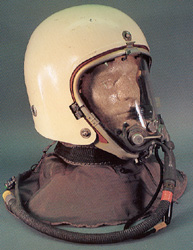 |
US Military Aviation
Flight Helmets
USAF high altitude |
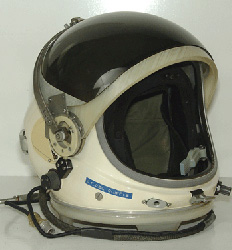 |
The high altitude helmets and relevant suits have been developed to protect the human body against the lack of pressure and extreme temperatures at high altitude. During the 30s the first experimental pressurized suit manufactured by B.F. Goodrich was worn by Wiley Post during an actual flight above 50,000 feet. Early prototypes of pressure suits have been developed and tested during the WWII but the full operative high altitude equipments were introduced in the US armed forces during the late 40s. The first partial pressure suit (S-1) was made by Dr. James Paget Henry in 1945, the S-1 evolved with anti-g capability into the T-1 partial pressure suit standardized in 1947. During the early 50s the USAF was mainly developing partial pressure suit thus USN was tasked with developing full pressure suits. USAF full pressure suits and relevant helmets was first developed in 1956 with the A/P22S-2 model suit and the MA-1 helmet. Full pressure equipment improvement in design, materials, mobility, and ventilation continued in the 60s and 70s with several different models of suits and helmets. The most advanced models used till today in SR-71 and TR-1 Reconnaissance aircrafts are respectively the S-1030 and S-1031C.
MX-117 Project
The MX-117 classified project was developed for the US Army Air Force during the late 30s early 40s by Goodrich and Goodyear to produce full-pressure suits.
This project results in several XH and X series (The X stands for eXperimental and the H for High altitude) of rubber suits designed for crew protection in the unpressurized B-17 Flying Fortress. Each suit incorportaed an improvement over earlier suits in the same series.
All of these model were flight tested by Major John Kearby and air crews in a B-17 and other types of combat aircraft at the Air Proving Ground Command over Eglin Field. None of the suits met the specification laid down by the Army Air Corps. For the most part they were stiff and becoming rigid and ballon-like when inflated. The project never reached the operational status and was cancelled completely on October 1943.
|
|
| Fishbowl type helmet of the XH-1 full-pressure stratosphere suit. This was the first of a series of HX types. (USAF) |
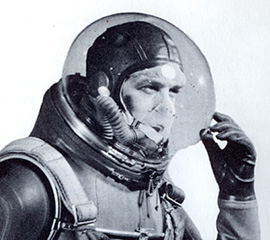
|
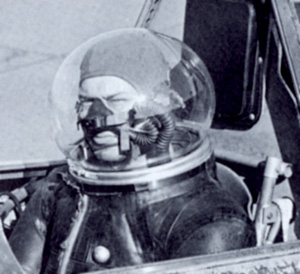
|
XH-3 flight evaluated by Major John G. Kearby in 1942 at Eglin Field from where he made many of his flight test. (USAF) |
| Fishbowl of the XH-5 full pressure suit. This suit looks like a space suit than anything before it. Nevertheless despite his "tomato-worm" design also this suit became too rigid when pressurized. (USAF) |
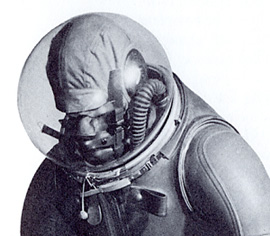
|
 |
S-1
The S-1 first high-altitude partial pressure suit and relevant helmet was handmade by Dr. James Paget Henry at the University of Souther California in 1945. This suit used the same counter-pressure applications of air-filled bladders as the g-suit to prevent undue shift of body fluids. Dr Henry wed external tubes with attached interlocking tapes to the suit fabric to pressurize the arms and legs of his partial pressure suit evenly. This system provides mechanical counterpressure along the limbs and sides of the body. Pressure breathing was possible at extreme altitudes through the use of a properly engineered helmet, eficiently sealed to the suit. |
|
| Dr. James Paget Henry handmade S-1 first partial pressure helmet and relevant outfit. |

|
 |
T-1 ; T-1A
The T-1 partial pressure suit and relevant helmet was an evolution of the S-1. The T-1 manufactured in 12 different sizes by David Clark Company was introduced in 1947 becoming the standard high-altitude outfit for the Major aircraft companies's and military test pilots. The full-face helmet was sealed by a thin rubber hood worn inside and adjusted tightly around the neck like a collar. A nylon outer hood supported the rubber inner hood and was also adjusted to fit snugly with laces and a zipper. The T-1A helmet produced by Mine Safety Appliance Co. was used by the U.S.A.F. and N.A.C.A. test pilots during their fligh on the first X planes. Standard avionics and a snap-on fibergals protective shell were used with the helmet. |
|
| T-1 full face high-altitude partial pressure helmet |
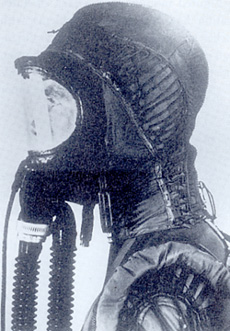
|
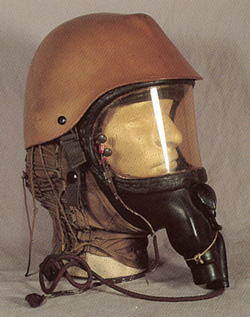
|
T-1A helmet with fibergalss protective shell.
(Schiffer Publishing Ltd.) |
 |
K-1 "Splitshell"
The K-1 "Splitshell" produced in the late 40s by International Latex Corp., was an evoluton of the original "Chatham" helmet design with many improvements for better comfort. The alluminum farme was padded and covered with soft leather, as were the earphone. Soft padded leather also replaced the critical rubber face seal. The white fiberglas outer protective shell is constructed in two halves, hence the nickname "Splitshell" They are held in place by angled mounting studs and a center flange which clips at the front and holds them rigid. The face plate was removable and was made from two flat pieces of tempered glass held in place by a hard rubber frame. This helmet was worn with the partial pressure suit T-1, S-2 and S-4. |
|
K-1 "Splitshell" high-altitude partial pressure helmet.
(Schiffer Publishing Ltd.) |
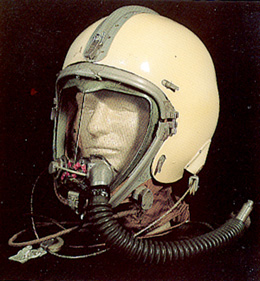
|
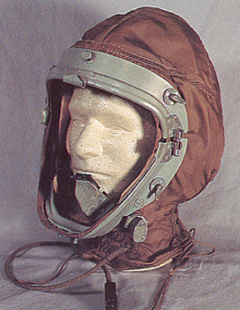
|
K-1 "Splitshell" inner hood/neck skirt with rigid metal frame.
(Schiffer Publishing Ltd.) |
K-1 "Splitshell" high-altitude partial pressure helmet. This specimen was worn with a S-4 Partial Pressure Suit. (www.bellsaviation.com)
|
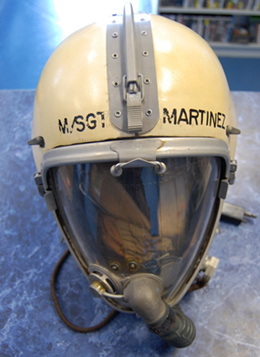
|
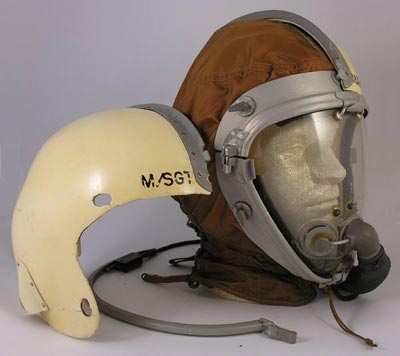
|
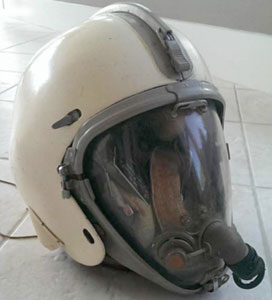
|
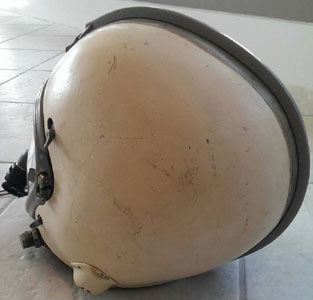
|
K-1 "Splitshell" high-altitude partial pressure helmet. This helmet was worn with S-2 partial pressure suit.
|
Another beautiful specimen of USAF K-1 "Splitshell" of the early of the 50s.
|
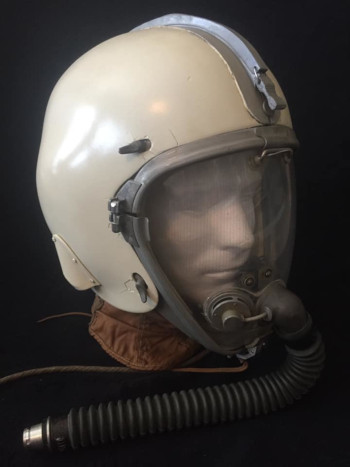
|
K-1
The K-1 high altitude partial pressure helmet made by International Latex Corporation was the first mass produced U.S. high altitude helmet in the early 50s. It was compouse by an inner hood/neck skirt with rigid metal frame and a one piece green fiberglass outer shell connected to the rigid metal frame of the hood. The removable face plate was made of molded plexiglas for light weight, improved visibility and cost reduction. It was electrical heated by way of tiny wires moded within and used a low pressure oxygen system. The K-1 was later used with the MA-2 face plate with the high pressure oxygen system.
|
USAF K-1 high altitude partial pressure helmet.
(Schiffer Publishing Ltd.) |
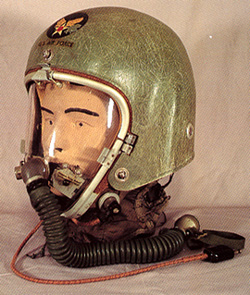
|
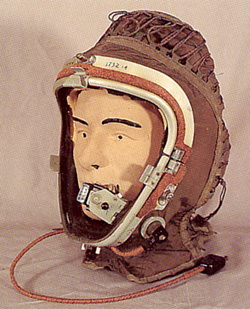
|
USAF K-1 high altitude partial pressure helmet hood/neck inner skirt with rigid metal frame. (Schiffer Publishing Ltd.) |
Very beautiful specimen of USAF K-1 high altitude partial pressure helmet dated 1956. (Tim Mackie)
|
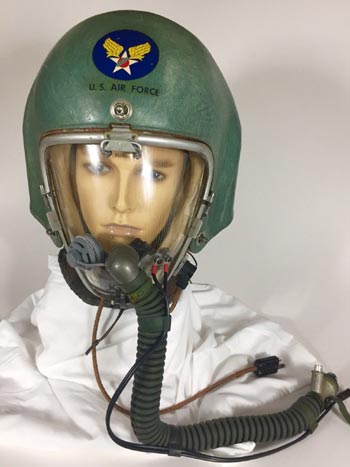
|
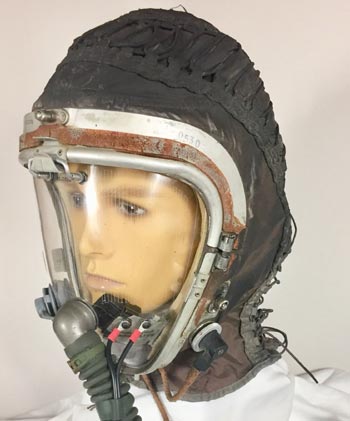
|
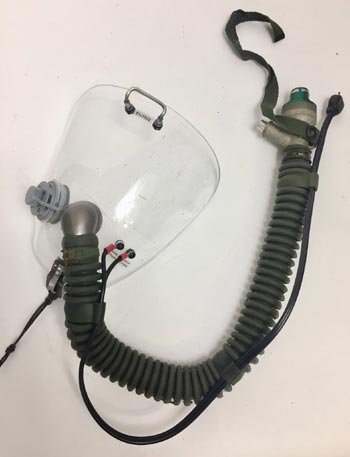
|
Faceshield of USAF K-1 high altitude partial pressure helmet. To avoid fogging the faceshield was heated with tiny wires molded inside the shield. (Tim Mackie) |
Another beautiful specimen of USAF K-1 high altitude partial pressure helmet dated middle of the 50s.
|
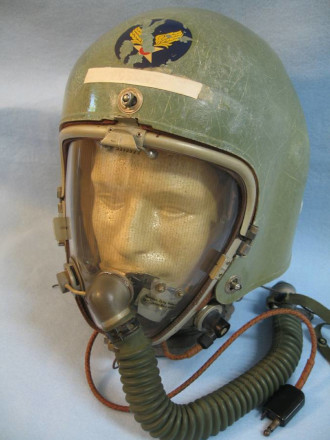
|
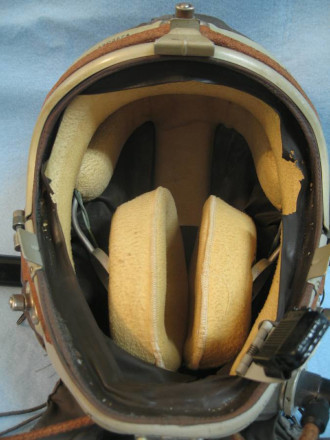
|
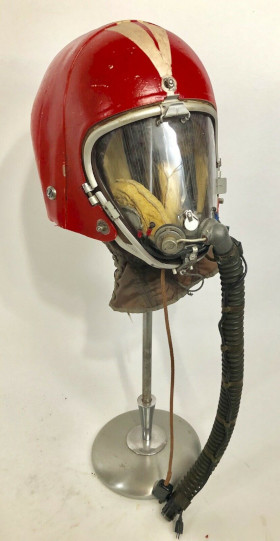
|
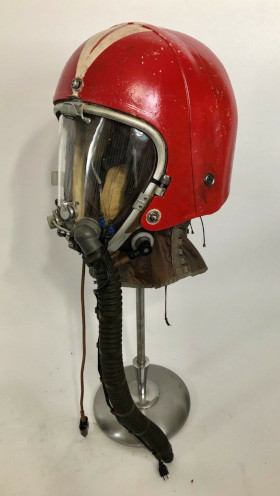
|
USAF K-1 high altitude partial pressure helmet of the middle of the 50s. |
New beautiful specimen of USAF K-1 high altitude partial pressure helmet dated middle of the 50s. (AERONANTIQUES.COM)
|
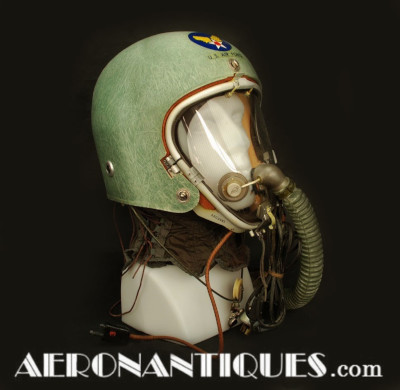
|
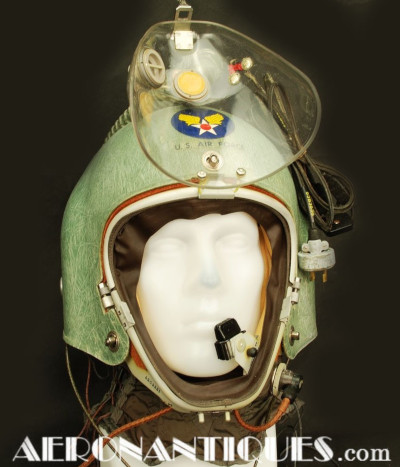
|
MB-5
The MB-5 external fiberglass shell was of one-piece construction (like the last K-1 shell), but was painted white. The MB-5 helmet assembly was quite similar to the K-1 helmet and was used mainly by SAC crews with the S-2, MC-1, and MC-3/MC-4 suits. It is very similar to the USAF K-1 helmet and has a liner with a short neck skirt, but the communications equipment is more like the later USAF MA-2 helmet, except with a longer communications cord. Partial pressure and full pressure suits and helmets are used to protect aviators from the effects of high altitude if their aircraft were to lose pressurization or if they were required to eject/bailout.
By 1959 records indicate that the standard USAF capstan pressure suits in use were the MC-3 and MC-4 series suits, routinely used with the MA-2 helmet assembly and MB-5 helmet assemblies. |
|
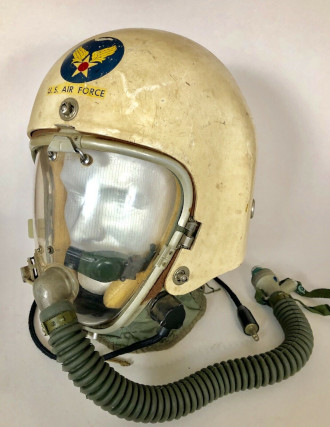
|
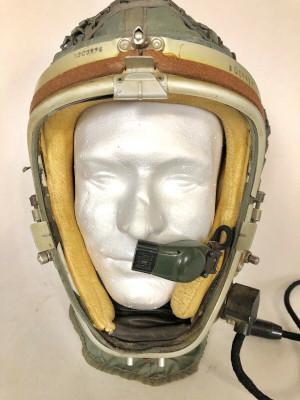
|
USAF MB-5 high-altitude partial pressure helmet dated 1956. (Tim Mackie)
|
USAF MB-5 high-altitude partial pressure helmet internal skirt and suspension padding system. (Tim Mackie)
|
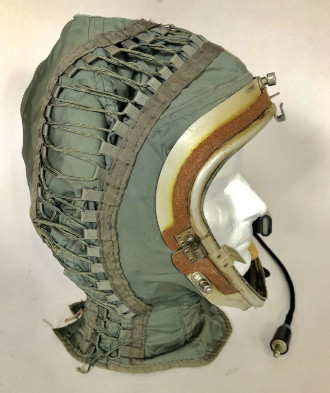
|
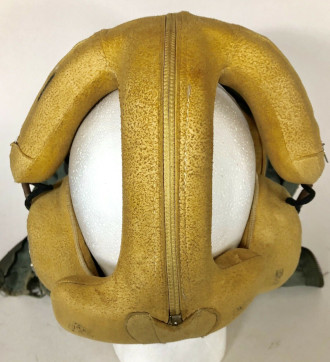
|
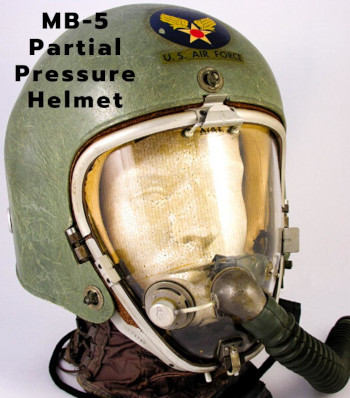
|
USAF MB-5 high-altitude partial pressure helmet dated 1956. The MB-5 helmet assembly was quite similar to the K-1 helmet and was used mainly by SAC crews with the S-2, MC-1, and MC-3/MC-4 suits. It is very similar to the USAF K-1 helmet and has a liner with a short neck skirt, but the communications equipment is more like the later USAF MA-2 helmet (Bellsaviation.com)
|
 |
MA-1
The USAF MA-1 high altitude helmet made by Bill Jack Instrument Company in the mid-1950s, was designed to give better visibility than the K-1 or MA-2 but suffered from high weight and oxygen leaks. It could be used with the T-1 and MC-1 type partial pressure suits or the A/P22S-2 full pressure suit which was the first USAF operational full pressure suit used by USAF.
The MA-1 visor was mechanically sealed by way of a top mounted tension bar mechanism and was electrically heated with vertically running tiny wires molded within.
The early MA-1 used a low presure oxygen system later replaced by a high pressure oxygen system with a smaller diameter reinforced hose. |
|
USAF early MA-1 with low pressure oxygen system.
(Schiffer Publishing Ltd.)
|
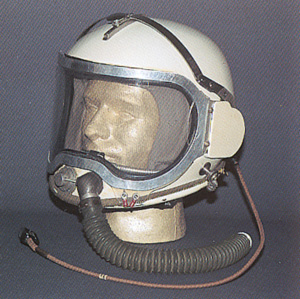
|
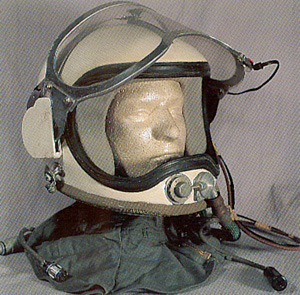
|
Later USAF MA-1 with high pressure oxygen system with smaller diameter hose. (Schiffer Publishing Ltd.) |
 |
MA-2
The MA-2 high altitude partial pressure helmet made by International Latex Corporation introduced in 1956 was very similar to the K-1 and MB-5 helmet except that a longer neck skirt was used with additional snaps to connect to the suit. An improved microphone, white fiberglass shell, high pressure oxygen system with small diameter reinforced hose and feeding port for water and food during long flights were also incorporated. The MA-2 helmet was used with T-1, MC-1, MC-3, MC-3A, MC-4 and MC-4A partial presure suits in several US aircraft well into the 60s. |
|
USAF MA-2 high altitude partial pressure helmet.
|
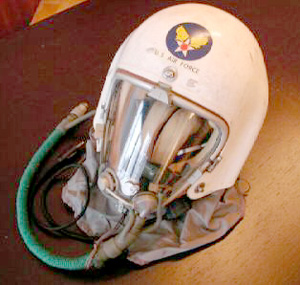
|
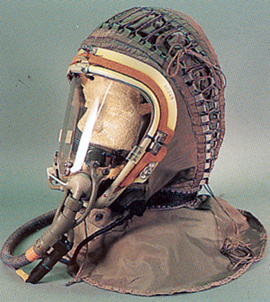
|
MA-2 inner hood/neck skirt face plate .
(Schiffer Publishing Ltd.) |
Lockheed "Skunk Works" MA-2 high altitude partial pressure helmet with modifications in the shell and face plate hoses connections (Blaster).
|
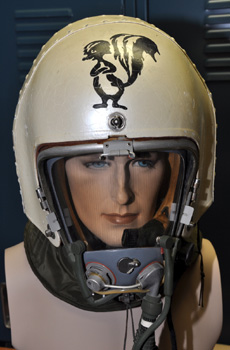
|
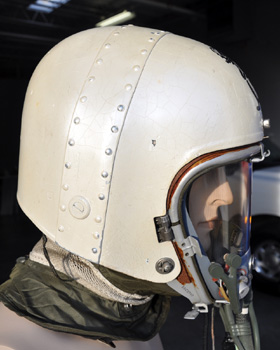
|
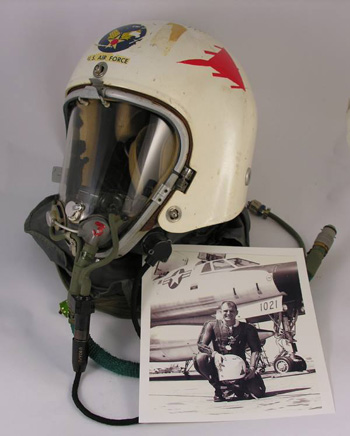
|
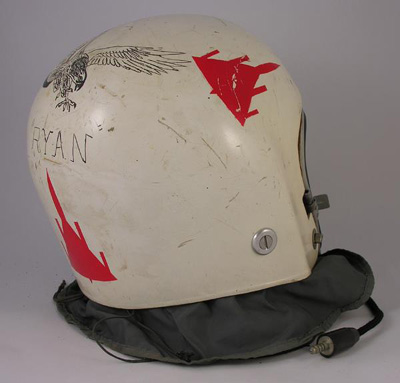
|
Beautiful specimen of USAF MA-2 Partial Pressure flight helmet used on B-58 test flight (Bellsaviation.com).
|
Well preserved specimen USAF MA-2 Partial Pressure flight helmet displayed at Smithsonian National Aviation Museum.
|
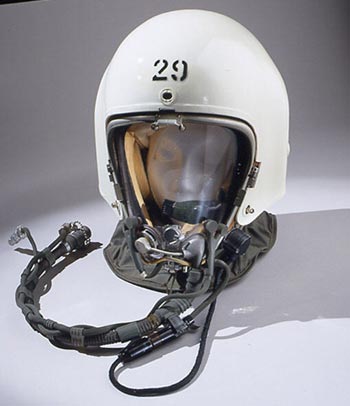
|
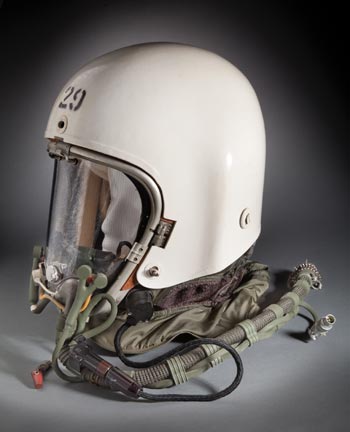
|
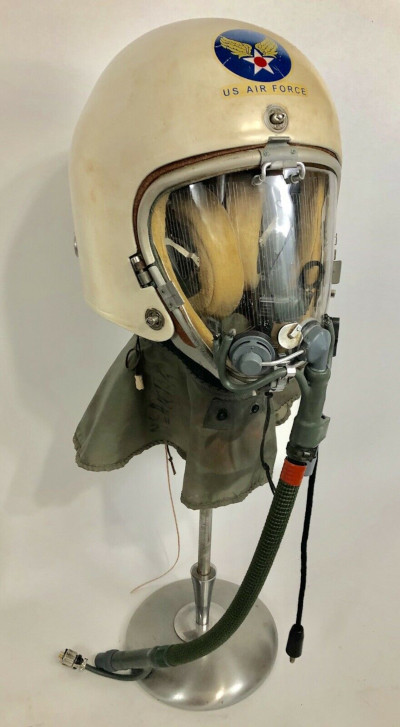
|
Well preserved USAF MA-2 Partial Pressure flight helmet used during the second half of the 50s.
|
MA-3
The MA-3 high altitude full pressure helmet made by the Bill Jack Instrument Company was used in fighter and tst aircraft in the early 60s. The MA-3 utilized the same cable restraint system as the K-1/MA-2. the tinted visor was mechanically sealed by way of a top mounted tension bar mechanism. Dry oxygen was pressure-fed into the face seal area to defog/defrost the visor. The MA-3 was used with either the CSU-4/P partial pressure suit or the A/P22S-2 full pressure suit. |
|
USAF MA-3 high altitude full pressure helmet.
(John Spencer) |
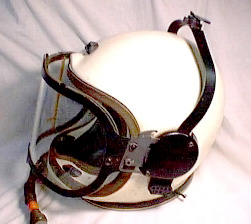
|
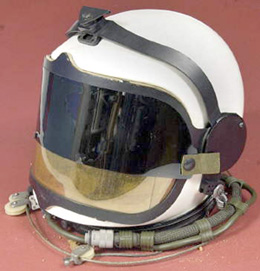
|
USAF MA-3 with additional dark sun protection visor installed on the helmet sealed visor. (Gato) |
Beautiful specimen of USAF MA-3 full Pressure flight helmet (Bellsaviation.com)
|
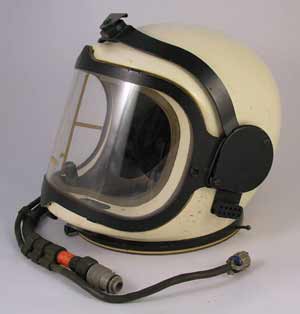
|
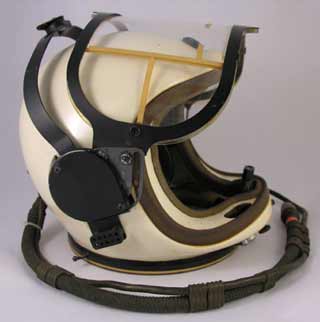
|
USAF MA-3 Partial Pressure flight helmet dated 1958, with cloth collar used with CSU-4/P partial pressure suit.
|
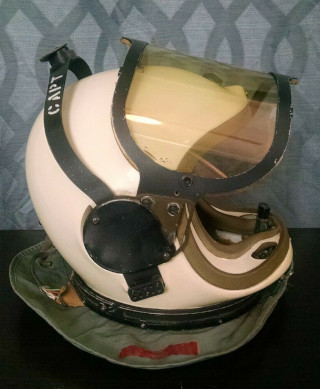
|
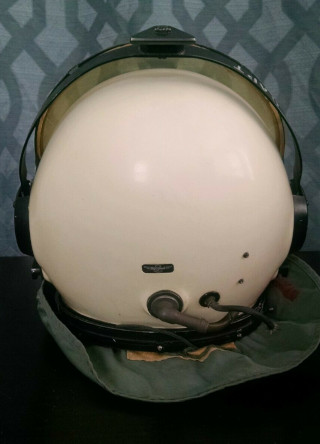
|
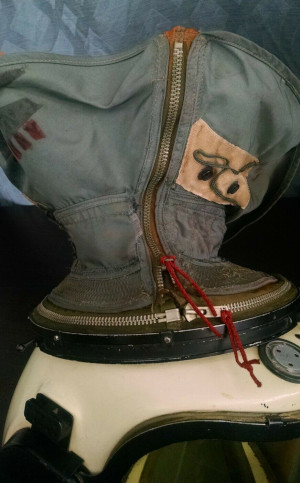
|
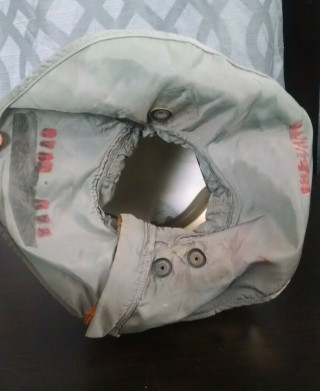
|
USAF MA-3 Partial Pressure flight helmet, detail of the cloth collar used with CSU-4/P partial pressure suit.
|
A/P22S-3 Type-1
The A/P22S-3 Type-1 high altitude full pressure helmet first produced in 1960 was the USAF version of the B.F. Goodrich USN Mark IV full pressure helmet. It was identical except for the silver knob tension system which permits the fit of any head by a series of nylon cords connected to the internal suspension system and pads, white color and USAF decal. The helmet shell was in fiberglass and had leather covered ear pads. The clear visor was sealed to the helmet by a presurized tubular gasket that is fed by bleed-off from the presure-fed oxygen system. |
|
The A/P22S-3 Type-1 full pressure helmet was the USAF version of the USN MK-IV full pressure helmet.
(Schiffer Publishing Ltd.) |
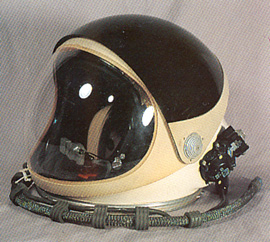
|
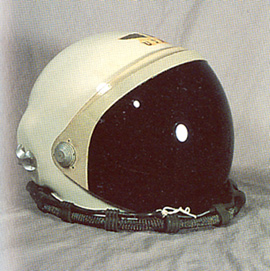
|
USAF A/P22S-3 Type-1 full pressure helmet with the tinted outer visor in down position.
(Schiffer Publishing Ltd.) |
Beautiful specimen of USAF A/P22S-3 Partial Pressure flight helmet used in limited quantity during the early of the 60s
|
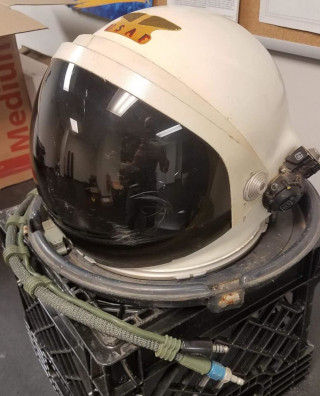
|
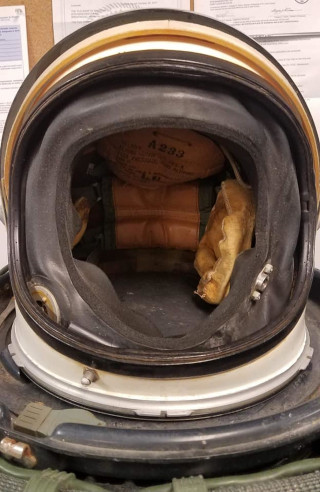
|
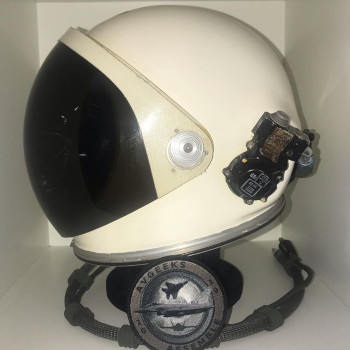
|
Other interesting specimen of USAF A/P22S-3 Partial Pressure flight helmet (Philippe Tondeur collection)
|
XMC-2
The USAF XMC-2 prototype high altitude full pressure helmet was developed during the 1958 by Protection Inc. The helmet shell was in fiberglass and used a mechanical visor seal. No tinted visor was used. |
|
USAF XMC-2 prototype high altitude full presure helmet. (Schiffer Publishing Ltd.)
|
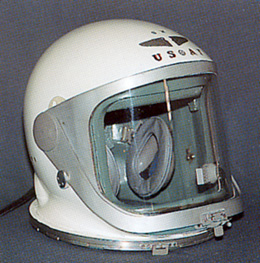
|
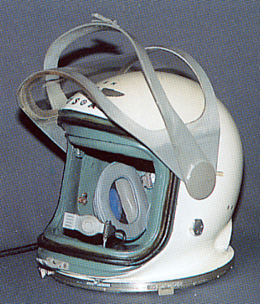
|
USAF XMC-2 prototype high altitude full presure helmet with the mechanically sealed visor in open position.
(Schiffer Publishing Ltd.) |
 |
MC-2
The MC-2 full pressure helmet made by Bill Jack Instrument Company during the early 60s was the evolution of the prototype XMC-2. The fibergalss shell was hand made and the tinted visor was mechanically sealed by way of a front mounted tension bar mechanism. The MC-2 was worn with an inner padded helmet for comfort and fit only. |
|
| USAF MC-2 high altitude full pressure helmet. (Schiffer Publishing Ltd.) |
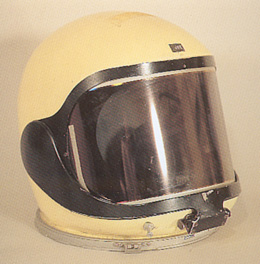
|
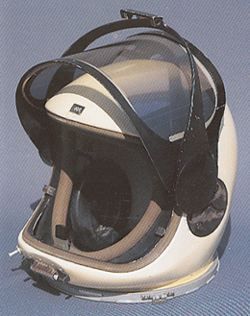
|
USAF MC-2 high altitude full pressure helmet with the mechanically sealed visor in open position. Note the center mounted microphone. (Schiffer Publishing Ltd.) |
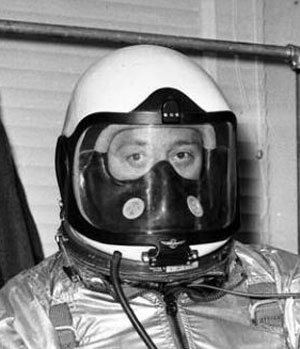
|
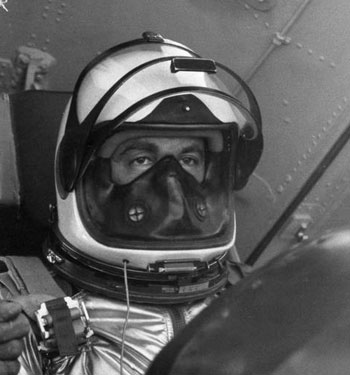
|
USAF MC-2 full Pressure flight helmet used in the early X-15 flight test
|
Beautiful specimen of USAF MC-2 Partial Pressure flight helmet (Bellsaviation.com)
|
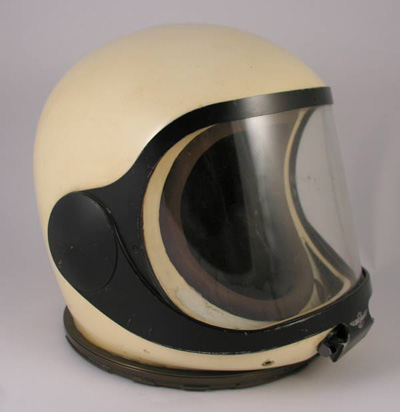
|
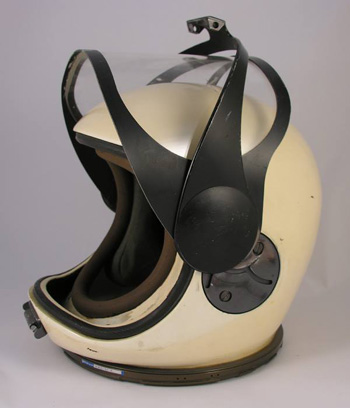
|
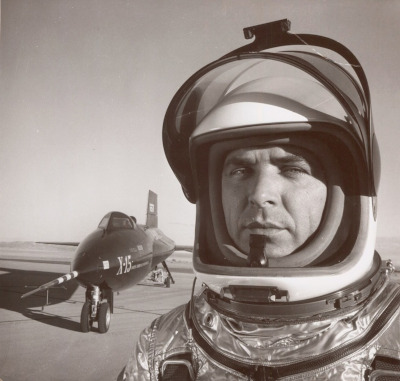
|
USAF Major Robert Michael White, military aircraft test pilot of X-15 with MC-2 Full Pressure flight helmet.
|
HGK-13 ; HGU-8
The HGK-13 full pressure helmet made by David Clark Company in 1960 has two oxygen hoses, one hose supplies breathing oxygen while the other provides 70 psi oxygen to pressurize the inflatable visor seal. The dual oxygen hoses enter the rear of the HGK-13 shell. The communication lead also contains the lead for the electric visor heater for defogging the visor. The HGK-13 was used with the A/P22S-2 (S-880) full pressure suit.
The HGU-8 partial pressure helmet is similar in design to the HGK-13 except for the dual oxygen hoses whose enter internally on the right side of the helmet and for a neck skirt which is stucked into the CSU-4/P partial pressure suit. |
|
HGK-13 full pressure helmet was used in the
X-15 experimental rocket aircraft.
(Schiffer Publishing Ltd.) |
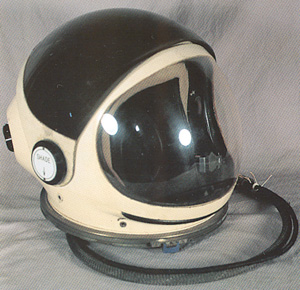
|
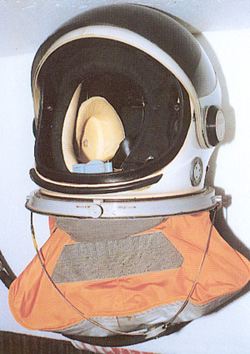
|
HGU-8 partial pressure helmet with neck skirt.
(Schiffer Publishing Ltd.) |
Beautiful specimen of USAF HGK-13 full pressure helmet (Bellsaviation.com)
|
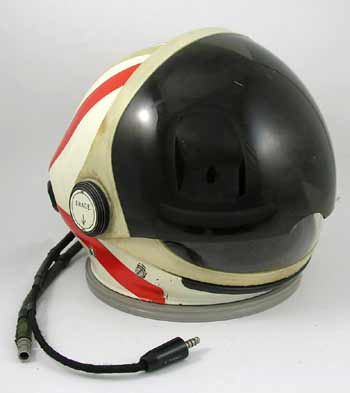
|
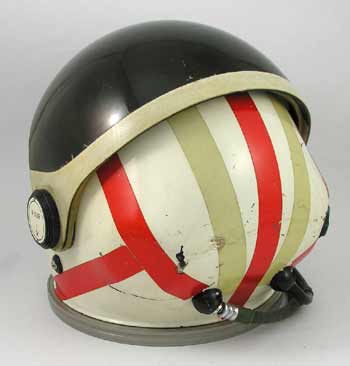
|
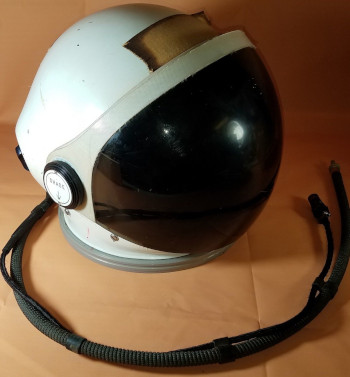
|
Another specimen of USAF HGK-13 full pressure helmet.
|
Well preserved specimen of USAF HGK-13 full pressure helmet used on X-15 (Philippe Tondeur collection)
|
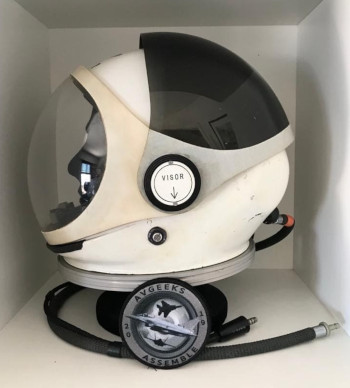
|
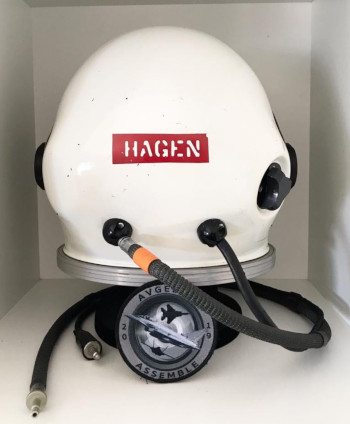
|
S-901
The S-901 high altitude full pressure helmet was first introduced in 1962 and used on A-12, YF-12A and SR-71. The S-901 helmet uses the HGK-13 shell and has internal dual oxygen hoses. Helmet used by pilots of SR-71 and U-2 aircraft generally do not have a designation but they simply go by the manufacturers' suit number, i.e. S-901. |
|
| USAF S-901 high altitude full pressure helmet.(Schiffer Publishing Ltd.) |
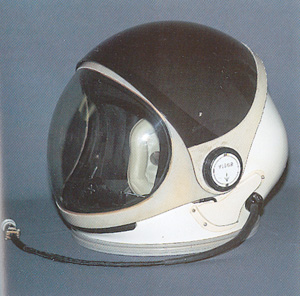
|
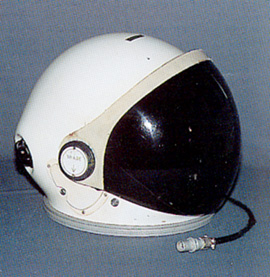
|
USAF S-901 high altitude full pressure helmet. Note the tinted visor actuator knob and the internal webbing adjustment take-up knob on the right side of the helmet's shell.
(Schiffer Publishing Ltd.) |
| Central Intelligence Agency S-901 high altitude full pressure helmet used on A-12 Oxcart spy plane during the middle of the 60s. |
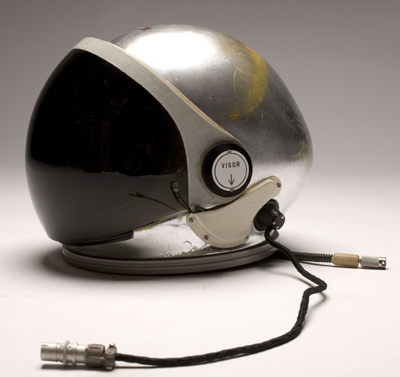
|
 |
S-1010
S-1010 high altitude full pressure helmet was designed and produced by the David Clark Company for the U-2C spy plane in the late 1960. Its visor is sealed by way of a mechanical tension bar system with a locking latch in front. A unique combination of articulated neck with hard-mounting neck ring is used to improve flexibility and pilot comfort. Just below the visor tension bar is located the anti-suffocation valve, the feed port is located at the left of the frontal latch system. The S-1010 was eventually replaced by the S-1010B helmet which is the same as the S-1030 helmet. |
|
S-1010 high altitude full pressure helmet .
(Schiffer Publishing Ltd.) |
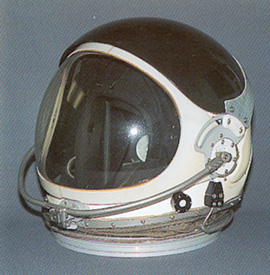
|
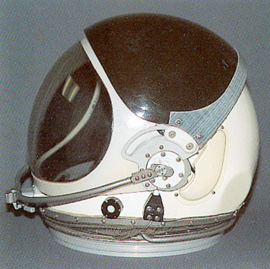
|
Lateral view of S-1010 high altitude full pressure helmet.
(Schiffer Publishing Ltd.) |
 |
HGK-19
The HGK-19 high latitude full presure helmet first made by the David Clark Company in 1965, as the standard USAF high altitude helmet used into the 1970s. The single oxygen hose HGK-19 was used with the A/P22S-4 and -6 full pressure suit. its visor is sealed by way of a mechanical tension bar system with a front locking latch. An internal head cushion is also used and contains the earphone assemblies and is attached by velcro to the inside of the helmet. Interna oxygen regulator, anti-suffocation valve and internal webbing adjustment take-up knob are aslo part of the helmet design. |
|
USAF HGK-19 high altitude full pressure helmet.
(Schiffer Publishing Ltd.) |
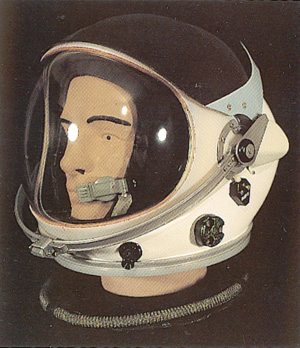
|
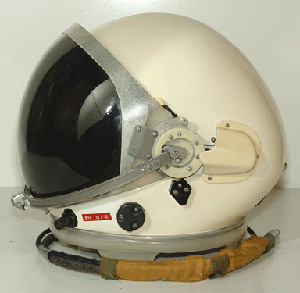
|
Lateral view of HGK-19 full pressure helmet with the tinted visor in down position. (flighthelmet.com) |
USAF SR-71 pilot Tony Bevacqua with HGK-19 high altitude full pressure helmet.
(USAF) |
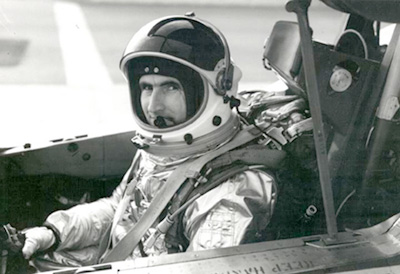
|
 |
S901J
The S-901J high altitude full pressure helmet is similar to the HGK-19 except for the addition of a dual oxygen hose system. A black switch located behind the visor mount determines which of the two oxygen system is used. The S-901J is used with the S-970 and S-901J full pressure suits. |
|
| USAF S-901J high altitude full pressure helmet. (Schiffer Publishing Ltd.) |
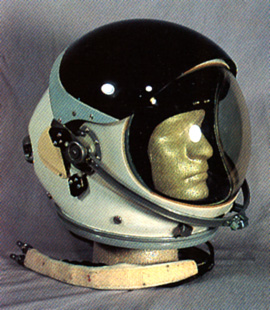
|
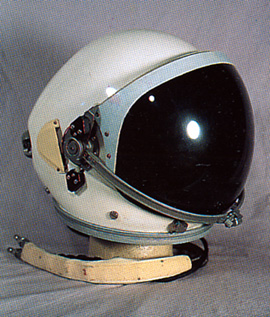
|
USAF S-901J high altitude helmet with tinted visor in down position. (Schiffer Publishing Ltd.) |
 |
S-1030 ; S-1031C
The S-1030 high altitude full pressure helmet was used in the SR-71 Blackbird in the late 70s and is similar to the HGK-19 helmet but with several modifications. The S-1030 has larger internal ventilation ducts, a diferent internal regulator and visor mechanism. This helmet used the same head cushion inserts and helmet hold-down system as the HGK-19. The S-1030 replaced the S-1010.
The S-1031 was used i the U-2R/TR-1 in 1991 and is essentially the same as the S-1030 but with no external microphone adjustment and modified visor tension bar catch. |
|
USAF high altitude full pressure helmet S-1030 used on Strategic Reconnaissance aircraft SR-71 Blackbird.
|
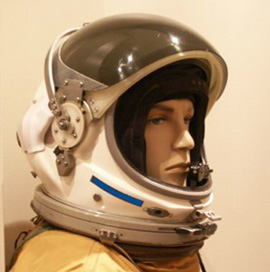
|
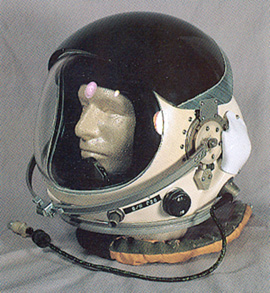
|
USAF S-1030 high altitude helmet. note the external microphone adjustment knob (below microphone) and anti-suffocation valve (to the right of microphone knob). (Schiffer Publishing Ltd.) |
USAF TR-1 pilot with S-1031 high altitude full pressure helmet. (Windrow & Greene Ltd.)
|
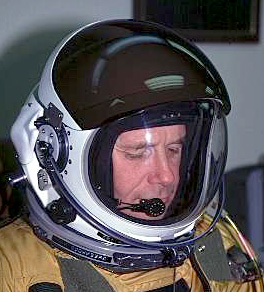
|
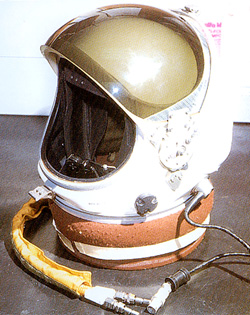
|
USAF S-1031 high altitude full pressure helmet.
(Windrow & Greene Ltd.) |
 |
|





















































































